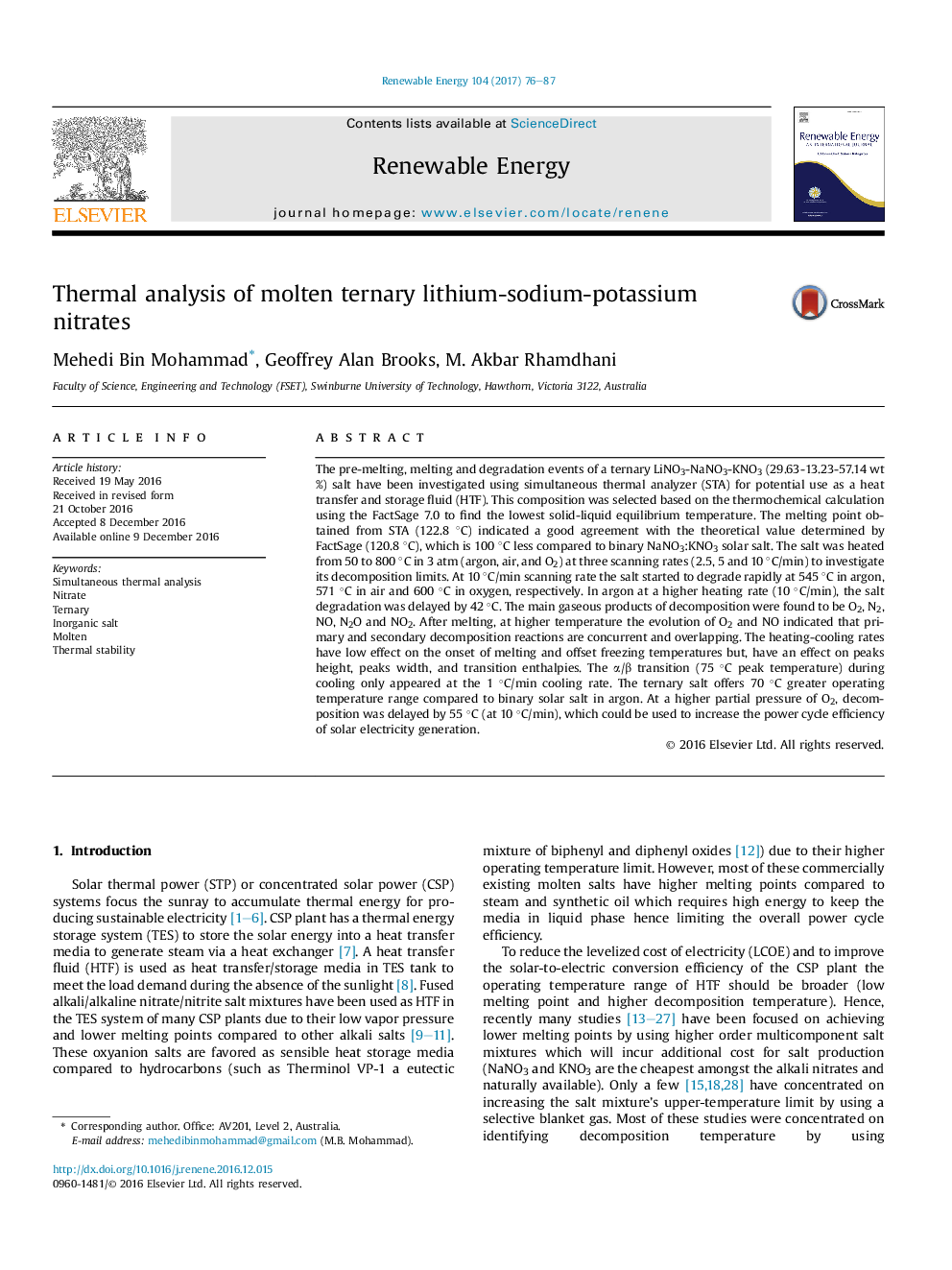| کد مقاله | کد نشریه | سال انتشار | مقاله انگلیسی | نسخه تمام متن |
|---|---|---|---|---|
| 4926772 | 1431600 | 2017 | 12 صفحه PDF | دانلود رایگان |
عنوان انگلیسی مقاله ISI
Thermal analysis of molten ternary lithium-sodium-potassium nitrates
ترجمه فارسی عنوان
تجزیه و تحلیل حرارتی نیترات لیتیوم سدیم-پتاسیم ترشی دندانی
دانلود مقاله + سفارش ترجمه
دانلود مقاله ISI انگلیسی
رایگان برای ایرانیان
کلمات کلیدی
تجزیه و تحلیل گرمایی همزمان، نیترات، سه گانه، نمک معدنی، پودر پایداری حرارتی،
موضوعات مرتبط
مهندسی و علوم پایه
مهندسی انرژی
انرژی های تجدید پذیر، توسعه پایدار و محیط زیست
چکیده انگلیسی
The pre-melting, melting and degradation events of a ternary LiNO3-NaNO3-KNO3 (29.63-13.23-57.14 wt%) salt have been investigated using simultaneous thermal analyzer (STA) for potential use as a heat transfer and storage fluid (HTF). This composition was selected based on the thermochemical calculation using the FactSage 7.0 to find the lowest solid-liquid equilibrium temperature. The melting point obtained from STA (122.8 °C) indicated a good agreement with the theoretical value determined by FactSage (120.8 °C), which is 100 °C less compared to binary NaNO3:KNO3 solar salt. The salt was heated from 50 to 800 °C in 3 atm (argon, air, and O2) at three scanning rates (2.5, 5 and 10 °C/min) to investigate its decomposition limits. At 10 °C/min scanning rate the salt started to degrade rapidly at 545 °C in argon, 571 °C in air and 600 °C in oxygen, respectively. In argon at a higher heating rate (10 °C/min), the salt degradation was delayed by 42 °C. The main gaseous products of decomposition were found to be O2, N2, NO, N2O and NO2. After melting, at higher temperature the evolution of O2 and NO indicated that primary and secondary decomposition reactions are concurrent and overlapping. The heating-cooling rates have low effect on the onset of melting and offset freezing temperatures but, have an effect on peaks height, peaks width, and transition enthalpies. The α/β transition (75 °C peak temperature) during cooling only appeared at the 1 °C/min cooling rate. The ternary salt offers 70 °C greater operating temperature range compared to binary solar salt in argon. At a higher partial pressure of O2, decomposition was delayed by 55 °C (at 10 °C/min), which could be used to increase the power cycle efficiency of solar electricity generation.
ناشر
Database: Elsevier - ScienceDirect (ساینس دایرکت)
Journal: Renewable Energy - Volume 104, April 2017, Pages 76-87
Journal: Renewable Energy - Volume 104, April 2017, Pages 76-87
نویسندگان
Mehedi Bin Mohammad, Geoffrey Alan Brooks, M. Akbar Rhamdhani,
